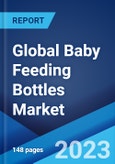The global baby feeding bottles market size reached US$ 2.9 Billion in 2022. Looking forward, the market is expected to reach US$ 3.8 Billion by 2028, exhibiting a growth rate (CAGR) of 4.61% during 2022-2028.
Baby feeding bottles, or nursing bottles, are childcare products used for feeding infants and young children. The bottles consist of a rubber teat to assist the baby in consuming milk, water, infant formula and other liquids. They are manufactured using plastic, silicone, glass and stainless-steel materials and are available in varying capacities. They are highly convenient for infants to drink liquids from and toddlers once they stop breastfeeding. Baby feeding bottles enable the parents to monitor the food intake of the child with enhanced flexibility.
Baby feeding bottles, or nursing bottles, are childcare products used for feeding infants and young children. The bottles consist of a rubber teat to assist the baby in consuming milk, water, infant formula and other liquids. They are manufactured using plastic, silicone, glass and stainless-steel materials and are available in varying capacities. They are highly convenient for infants to drink liquids from and toddlers once they stop breastfeeding. Baby feeding bottles enable the parents to monitor the food intake of the child with enhanced flexibility.
Baby Feeding Bottles Market Trends
The increasing prevalence of lactose intolerance among infants across the globe is one of the key factors driving the market growth. Moreover, rising female workforce participation and the shifting consumer preference toward infant formula are providing a thrust to the market growth. Infant and baby food manufacturers are developing products with high nutritional content and appealing flavor profiles. These products substitute breastfeeding and enable the parents to meet the nutritional requirements of the child. Additionally, various product innovations, such as the launch of bisphenol (BP) A-free and stainless-steel baby feeding bottles, are acting as other growth-inducing factors. Product manufacturers are also developing premium-quality medical-grade silicone feeding bottles with offset nipples to promote latching and minimize bottle rejection. Novel variants also contain a dual venting system to reduce colic and facilitate proper airflow. In line with this, aggressive promotional activities by manufacturers through celebrity endorsements and marketing campaigns on social media and e-commerce platforms are also contributing to the market growth. Other factors, including rising expenditure capacities of the consumers, along with the increasing birth rate across the globe, are anticipated to drive the market toward growth.Key Market Segmentation
This research provides an analysis of the key trends in each sub-segment of the global baby feeding bottles market report, along with forecasts at the global, regional and country level from 2023-2028. The report has categorized the market based on material type, capacity and distribution channel.Breakup by Material Type:
- Plastic
- Stainless Steel
- Silicone
- Glass
Breakup by Capacity:
- Up to 4 Oz
- 4.1 to 6 Oz
- 6.1 to 9 Oz
- More than 9 Oz
Breakup by Distribution Channel:
- Supermarkets and Hypermarkets
- Convenience Stores
- Retail Pharmacies
- Online Stores
Breakup by Region:
- North America
- United States
- Canada
- Asia-Pacific
- China
- Japan
- India
- South Korea
- Australia
- Indonesia
- Europe
- Germany
- France
- United Kingdom
- Italy
- Spain
- Russia
- Latin America
- Brazil
- Mexico
- Middle East and Africa
Competitive Landscape
The competitive landscape of the industry has also been examined along with the profiles of the key players being Artsana S.p.A., Babisil International Ltd., Cherub Baby, Handi-Craft Company, Kleine Giraf BV, Koninklijke Philips N.V., Mason Bottle, Mayborn Group Limited, Munchkin Inc., nanobébé US LTD, Pacific Baby Inc., Pigeon Corporation and Steribottle Ltd.Key Questions Answered in This Report:
- How has the global baby feeding bottles market performed so far and how will it perform in the coming years?
- What has been the impact of COVID-19 on the global baby feeding bottles market?
- What are the key regional markets?
- What is the breakup of the market based on the material type?
- What is the breakup of the market based on the capacity?
- What is the breakup of the market based on the distribution channel?
- What are the various stages in the value chain of the industry?
- What are the key driving factors and challenges in the industry?
- What is the structure of the global baby feeding bottles market and who are the key players?
- What is the degree of competition in the industry?
Table of Contents
1 Preface3 Executive Summary11 Value Chain Analysis13 Price Analysis
2 Scope and Methodology
4 Introduction
5 Global Baby Feeding Bottles Market
6 Market Breakup by Material Type
7 Market Breakup by Capacity
8 Market Breakup by Distribution Channel
9 Market Breakup by Region
10 SWOT Analysis
12 Porters Five Forces Analysis
14 Competitive Landscape
Companies Mentioned
- Artsana S.p.A.
- Babisil International Ltd.
- Cherub Baby
- Handi-Craft Company
- Kleine Giraf BV
- Koninklijke Philips N.V.
- Mason Bottle
- Mayborn Group Limited
- Munchkin Inc.
- nanobébé US LTD
- Pacific Baby Inc.
- Pigeon Corporation
- Steribottle Ltd.
Methodology

LOADING...
Table Information
| Report Attribute | Details |
|---|---|
| No. of Pages | 148 |
| Published | November 2023 |
| Forecast Period | 2022 - 2028 |
| Estimated Market Value ( USD | $ 2.9 Billion |
| Forecasted Market Value ( USD | $ 3.8 Billion |
| Compound Annual Growth Rate | 4.6% |
| Regions Covered | Global |
| No. of Companies Mentioned | 13 |









